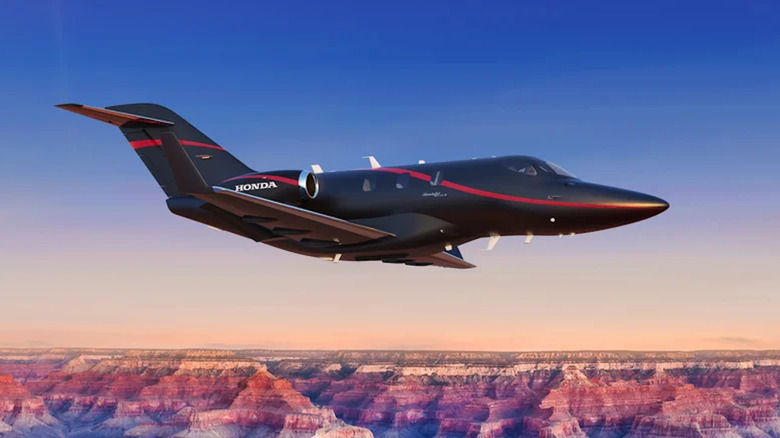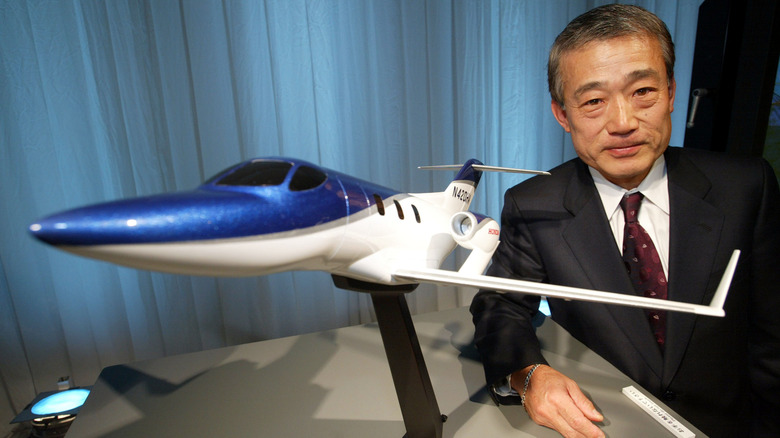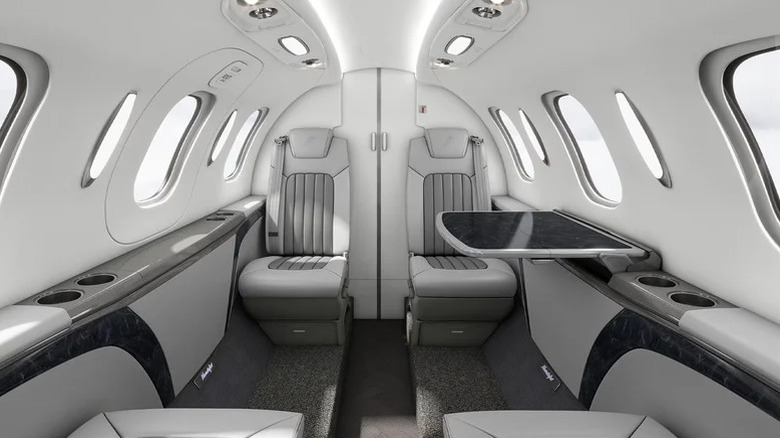How Much A Honda Jet Actually Costs (And Why It Started Making Planes)
When you think of Honda, the first thing that comes to mind is probably the trusty Civic, an affordable compact that's been a staple on roads for decades now. The company manufactures a range of vehicles, from motorcycles to SUVs, such as the renowned CR-V, as well as power equipment, including generators, lawn mowers, and marine engines. Point being, when Honda is mentioned, you wouldn't think to look to the sky. However, in 1986 the Japanese company decided to begin research into what would eventually become its HondaJet division, where the first prototype jet was built in 1993. The company leveraged help from the Mississippi State University's Raspet Aeronautical Lab, beginning down the path of creating sleek business jets.
Fast forward more than thirty years, and jets like its gorgeous Elite II are now cruising the skies, signaling a refinement and quality Honda is known for. To own a Honda jet, you would need to put down a cool $6.95 million, allowing you to cruise the skies in style at Mach 0.69, privately. Honda's motivation for developing jets was simple: the company saw a gap in the market. Among companies like Gulfstream, Bombardier, Dassault, and Embraer, which have been producing impressive private jets for years, Honda was able to position itself competitively within the market. To wit, a similarly classed Bombardier Learjet 75 — the business plane often touted by rappers, rock stars, and elites — also holding 6 passengers, goes for $14 million, double the cost of an Elite II.
Success from takeoff
While Honda may almost be considered an "everyman" brand, making affordable and reliable cars for domestic markets around the world, its foray into luxury planes should be taken seriously. To back up a bit, when HondaJet officially debuted in 2015, the company hit the ground — or, jet stream — running, launching the brand and its jets to immediate success. It offered an alternative to established business jet brands, and with that, innovation. Sure, Honda's name might not carry the same luxury clout as Rolls-Royce, but despite that, it captured the imagination and attention of the private aviation industry. Shortly after HondaJet's debut, it was the most delivered small business jet for five years straight and, in 2018, launched its Elite plane. The 2.0 version came out in 2022, and by that point, with the Elite II making so many customers happy, HondaJet became known as one of the best offerings in the light jet industry.
Considering legacy outfits Bombardier sell planes at almost double the price of Honda's flagship private passenger jet, it goes to show how brand names can influence price points, and how Honda appears to be attempting — with much success — market disruption here. The company identified a space they could carve out in the marketplace, with its Elite II appealing to small charter companies where its engines have 20% more fuel efficiency than competitor light jets.
Engineering prowess and value proposition
Honda's aircraft division wanted to develop a modern, fuel-efficient and competitive business jet, and it's safe to say the company knew its engineers could give it an edge. Due to the engineering prowess of its R&D team, HondaJet can claim the title of being the world's first small private jet capable of nonstop transcontinental flights across the U.S. — pretty impressive for such a young aerospace outfit. Furthermore, the Elite II has advanced avionics, a highly customized Garmin G3000 glass cockpit, 20% more cabin room, and a max cruising altitude of 43,000 feet — impressive, to say the least. Its private planes have historically been able to offer low hourly operating costs relative to other small jets, which led to U.S., European, and Asian companies taking notice. Having its newest and most technologically advanced jet in your fleet means saving money — appealing to private owners — while maximizing profits for charter groups.
With plans of launching a forthcoming model called the Echelon next year, and hoping to get full Type certification for 2028, the future looks bright for HondaJet. The company was able to go up against tough competitors who had market dominance and brand equity decades deep, and as a young upstart, secured market share on the strength of good engineering. We know that Honda's cars seem to last forever, surely the same can — and will — be said of its jets.


